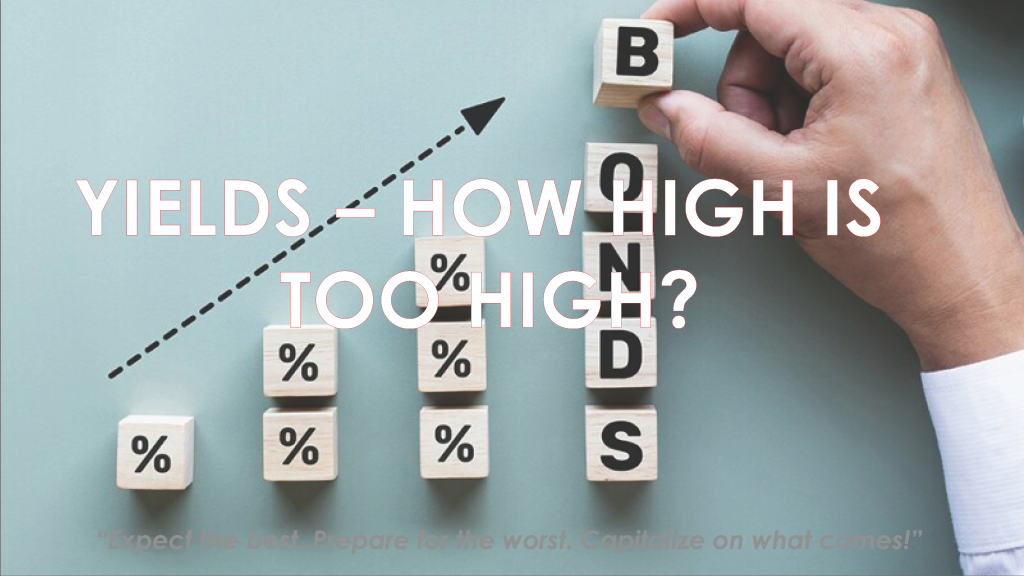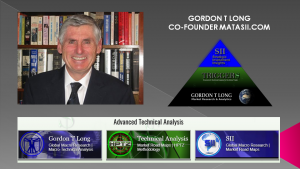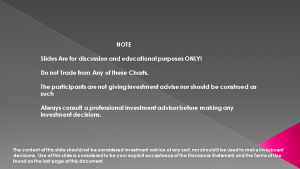IN-DEPTH: TRANSCRIPTION - LONGWave - 10-11-23 - OCTOBER - Yields: How High Is Too High?
SLIDE DECK
TRANSCRIPTION
SLIDE 2
Thank you for joining me. I'm Gord Long.
A REMINDER BEFORE WE BEGIN: DO NO NOT TRADE FROM ANY OF THESE SLIDES - they are COMMENTARY for educational and discussion purposes ONLY.
Always consult a professional financial advisor before making any investment decisions.
SLIDE 3 - COVER
I want to talk about surging global yields and the US Bond Market in this session of our Monthly LONGWave video. For those only interested in equities and the stock market there has never been a more important time than now to understand what is going on in this normally quiet and boring Bond market.
Today, it is anything but that and is actually currently in control of global equity markets.
SLIDE 4
I don’t believe that is much of an exaggeration which hopefully you will appreciate why as we cover the subjects outlined here. I am doing this video as I return from Europe on US Columbus Day weekend so it may be somewhat dated when you actually receive it
SLIDE 5
Before we get into the details, let me start with what you need to know if you are not already fully aware of what is currently occurring.
SLIDE 6
After peaking in July 2020, and in the subsequent 28 months of draw downs amounting to a record 25%, this is now the single greatest bond BEAR market of all time!
SLIDE 7
Long-Term Treasuries with duration risk have fallen an astounding 45%.
This is capital lose that has major ramifications as it is often this capital that is used as collateral across the global financial system.
SLIDE 8
The Bond Bear Market not a US problem, but a global problem as yields have spiked with a corresponding drop in price and value around the world.
Global yields hit a 15 year high to defy bond bulls expecting a near term central bank pivot.
SLIDE 9
It has gotten so bad and relentless recently that it has shifted traders from an obsession with Artificial Intelligence and the Magnificent 7, to the destruction the Bond Bear market may potentially cause.
SLIDE 10
The surge in yields has been extreme, but you need to note we are putting in a possible shooting star candle here. RSI is at extreme levels, and we are 32 bps above the 21 day moving average as of writing.
There is a strong possibility that we are very near a short term top.
These sorts of spikes in my experience are often signals of a major long term structural trend change. Expect a consolidation and support test – but the longer term trend is highly likely higher!
SLIDE 11
The fear of the fallout has obviously spilled over into Equity Fear-Greed Indices, taking it to “Extreme Fear” measures and longer term lows.
SLIDE 12
We warned this was coming with the end of the 40 year “Great Moderation” in our January Annual Thesis paper.
SLIDE 13
We said we needed to expect:
- Increased volatility,
- High Inflation,
- High Interest Rates and
- High Risk Premiums!
SLIDE 14
We said risk Premia for Duration in the Bond Market would rise.
We also said Risk Premiums for Equities would rise. This has not yet happened for equities but should be expected to soon happen resulting in falling equity prices.
Rising Risk premiums is happening because markets are becoming much more risky and investors are requiring bigger premiums to take that risk. There are also other factors at play associated with Supply and Demand, decreased market makers and banks existing problems with Treasury holding values which are further compounding the problems.
SLIDE 15
Going forward it is extremely important that you keep your eyes on BOTH the short and long term DRIVERS.
In the short term those Drivers are spiking real rates, tightening financial conditions as reported by the Fed’s Financial Conditions Index and the severity of the Recession which is clearly on the horizon.
In the longer term those Drivers are increasingly going to be Monetary and Fiscal Policy initiatives. Current spiking Real Rates will give way again to rising Inflation Break-Even levels.
We need to expect yields to rise in increasing waves – each wave being larger than the last. It is highly likely that Inflation will be with us for the rest of this decade.
As a result you can expect Yield Curve Control along with Price and Capital Controls to emerge as policy responses.
Expect Credit Creation to increasingly come from new Federal Reserve Credit Facilities and Banking Regulation Changes.
Expect the US Treasury to use Credit Guarantee facilities such as Contingent Liability Accounting.
Liquidity, the “Mothers Milk” of financial markets will best be viewed in the short term not by the Fed’s Balance sheet growth as we have become accustomed to, but rather by watching the RRP falling at a faster rate than falling Fed Bank Reserves.
Longer Term we can expect the Fed’s Balance sheet to explode to levels much higher that they peaked at prior to the current policy of Quantitative Tightening. In the interim the Inverted Fed Balance Sheet will continue to mirror the US 10Y Yield.
We need to pay particular attention to the fact that Gold is becoming less sensitive to Real Rates and more attuned to Geo-Political Risk and central bank buying by the BRICS-11.
SLIDE 16
In the short term - what will stop this exploding rise in rates?
SLIDE 17
Historically, current rate levels should have already taken their toll and brought about a Fed reversal.
But after a decade of Quantitative Easing, Corporations have locked in rates at historic lows while Home Owners also locked in Fixed Mortgages at low rates.
This has made normal Monetary Policy less effective and is taking much longer and more protracted than has normally been the case.
Additionally, massive Fiscal Deficits as a result of Bidenomics is pumping large amounts of liquidity into the system avoiding tightening banking lending standards.
SLIDE 18
Traditionally, something should have broken by now despite these off-setting factors. In fact we have seen major financial fractures such as
- The Pension-LDI crisis earlier in the UK that took down the Prime Minister,
- The Silicon Valley Bank collapse and the Fed’s Bail-out using the Bank Term Funding Program
- The Ongoing collapse within the Office Space of the Commercial Real Estate sector.
SLIDE 19
All of these have so far have been contained which has allowed rates to only rise further.
Clearly it is going to take something much larger or rates will only rise further towards major overhead technical resistance levels.
SLIDE 20
As investors we actually have our eyes closely on Real Rate versus Nominal Rates as being the trigger that breaks something major this time.
SLIDE 21
The fact that Treasury Yields are tracking so closely to the Fed Balance Sheet shrinkage due to its Quantitative Tightening or QT program, suggests there is a “limiting correlation point” for both.
We will talk about that in a moment.
SLIDE 22
Slowing global trade is now so severe that it hard to see how the many major developed economies will avoid a recession. There is a wide view of opinions on a coming recession, if at all.
We strongly feel that though the Recession may be delayed, it is coming short of massive increasing global Fiscal Deficit spending, which will only add serious fuel to an already globally burning Inflation fire.
SLIDE 23
The US National debt since the introduction of Quantitative Easing is now growing faster than the US Economy. Liquidity has temporarily camouflaged the seriousness of this occurrence.
SLIDE 24
With spiking interest rates the US government is not as protected from rising rates as many corporations and home owners presently are. Government policy simply failed to capture low rates for existing debt.
Now with a $2T Fiscal Budget gap needing financing along with $8T in rollover of existing US Treasury debt, the US has a $10T funding requirement. This is going to spike the already existing Federal Government Expenditures Annualized Interest Payment (shown here) to well past the $1T mark.
SLIDE 25
The financing of the US Government is now effectively crowding out credit to rest of the economy.
Slowing Credit growth with tighter bank lending standards and financial conditions can be expected to slowly strangle the US economy in an era of Stagflation.
Unfortunately the problem is even bigger than this!
The global spike in yields is presently estimated to have resulted in a value destruction of around $70T over the last two years. For context, the global equity market is worth around $107T and the IMF suggests the global economy will be worth $105T in 2023.
Other analysts suggest the number is realistically lower, and more in the area of $16T.
Whether it is $16 trillion or $70 trillion, or somewhere in between, the scale of losses in debt markets resulting from the Fed error of keeping rates too low for too long, and now overcompensating with its fastest rate hike cycle since Volcker, are the largest in history in dollar terms and relative to GDP.
The question is an obvious "Can the system absorb this without any further accidents?"
The answer is not if, but when will the accident occur and will it be global in nature?
SLIDE 26
We have a lot of early warnings that tells us that financial institutions are preparing for a storm!
SLIDE 27
I have used this analogy many times, so for a long time viewers bare with me for a moment.
It has been my experience that like a dog, some markets like the Credit Market often smells trouble before it sees or hears it. Its hearing and sight as represented by the Bond and Currency Markets are then quickly focused.
Meanwhile its equity tail may still be wagging until it knows if it is a threat or friend? The equity market is like the tail on the dog – the last to visibly signal a threat.
This is why we spend so much time on the Credit, Bond and Currency Market evaluations before making Equity decisions.
SLIDE 28
The High Yield or Junk Market despite rising rates, last week broke the critical support line we have been warning to watch closely. We highlighted this in last weekend’s newsletters.
The Death Crosses in the 50/100/200 DMA as well as the culmination of an intermediate term continuation triangle suggest we are at the beginning of the next down leg!
If this leg decisively breaks the COVID lows, which brought the Fed into supporting the Corporate Bond Market for the first time in history, then the downside may be quite serious.
SLIDE 29
The Flows since the July FOMC Meeting have been warning us that this was going to occur.
SLIDE 30
Additionally, the Bond volatility MOVE Index and the US High Yield Spread were sending disconnects that needed to be resolved.
SLIDE 31
The suddenly deteriorating strong US Dollar was also giving us a warning. Until the US Dollar breaks its 200 DMA we will consider the dollar in a trading range in the near term though we see a stronger correction when the Fed finally pivots.
Longer-Term we are against the consensus view and see US Dollar strength as a global flight to safety will still lead to US dollar buying only because of the size of its global trade settlement usage.
SLIDE 32
We are at a critical support level for the S&P 500 at the time of producing this video and the jury is still out on how this will be resolved in the short term.
SLIDE 33
Looking at some key Fundamentals may assist us in that regard as well as where yields are headed in the short term. Falling Yields are normally good for equities.
SLIDE 34
The recent rise in the Fed’s Financial Conditions Index since its’ July FOMC Meeting has been a major driver in rising Real Rates which has underpinned the rapid rise in Yields while the Fed has basically been on hold.
SLIDE 35
This recent rise in the FCI has been quite strong which has matched the rise in Real Rates.
SLIDE 36
The Fisher Equation reminds us that Nominal Bond Yields are equal to the sum of Inflation Break-Even rates and the Real Rate.
SLIDE 37
Inflation Break-Even Rates have not been a contributor as the rise in Real Rates dwarf the activity in Inflation Break-Evens.
SLIDE 38
We have long held that the upper level for 10Y Real Rates was 2.5%.
We are not quite there yet but we are close.
It the short term we suspect this will trigger a consolidation in 10Y Yields at lower levels.
SLIDE 39
In the Intermediate and Long Term we expect higher rates due to inflation, remembering the Fed may change Policy at anytime and Geo-Political Event Risk is more prevalent than ever!
However, the Fed is powerless to contain an Inflation surge due to rising Energy and Food prices without much higher yields, a Recession or a major Geo-Political Event.
SLIDE 40
The Technical’s clearly support our analysis.
SLIDE 41
Our Weekly 10Y Treasury Yield chart has achieved our Mid September objective and may even touch the upper 3 Sigma Bomar band. This was last touched in 2013.
SLIDE 42
Our Shorter-Term hourly chart of the 10Y Treasury Yield is giving a strong indicator we are at a level that normally requires a consolidation period to go higher OR is a short to Intermediate Term Top.
SLIDE 43
Elliot Wave practitioners are calling for an important correction somewhere in here, taking us to lower yields in the 2-2.5% range before launching the next surge in rates to new highs.
As we mentioned earlier, expect inflation and rates to move higher in waves!
SLIDE 44
What can we conclude from this?
SLIDE 45
Yields are very near a short to Intermediate high.
They will correct when the Fed changes policy as something breaks and the US Recession arrives. The rates will not go as low as the market currently expects, but will trade within a trading range before Inflation ravages the markets again.
SLIDE 46
The key messages we laid out earlier may now make a little more sense. Print them and keep them as reminders of what to keep your eyes on.
Expect the unexpected!
This won’t be easy, but for those who do their homework there will be investments to be made!!
SLIDE 47
As I always remind you in these videos, remember politicians and Central Banks will print the money to solve any and all problems, until such time as no one will take the money or it is of no value.
That day is still in the future so take advantage of the opportunities as they currently exist.
Investing is always easier when you know with relative certainty how the powers to be will react. Your chances of success go up dramatically.
The powers to be are now effectively trapped by policies of fiat currencies, unsound money, political polarization and global policy paralysis.
SLIDE 48
I would like take a moment as a reminder
DO NO NOT TRADE FROM ANY OF THESE SLIDES - they are for educational and discussions purposes ONLY.
As negative as these comments often are, there has seldom been a better time for investing. However, it requires careful analysis and not following what have traditionally been the true and tried approaches.
Do your reading and make sure you have a knowledgeable and well informed financial advisor.
So until we talk again, may 2023 turn out to be an outstanding investment year for you and your family?
I sincerely thank you for listening!






